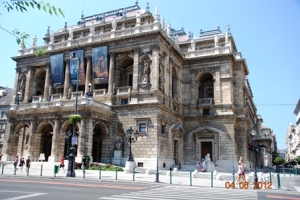A motley crew of Italians, French, Germans and us headed by our very able and competent guide Attila (the hun!) boarded Petnehazy’s mini van excitedly for the very first guided city tour of Budapest. With introductions made, the day’s agenda passed around and the sun out in full swing, our minivan sped towards the Buda end of the Chain Bridge – promising a day of history, culture and European art.
The Danube glittered in the morning sun, blue sky made no pretence of the warm day ahead and Attila said everything there was to say in English, French, Italian and German in cyclic fashion.
Fishermen seemed to play quite a significant role in Buda’s history as we were about to see. Enroute to the top of the Buda hill is the medieval Watertown that bears memory to the fisherman who lived and worked there. The streets here are named in their memory. So there’s Hook Street, Harpoon Street, Perch Street, Catfish Street so on!
First stop, the Castle District atop the Buda hill. The southern end of this hilltop plateau houses several historical places of interest – the major ones being the King Matthais Church (officially known as the Church of Our Lady), the Holy Trinity, the fisherman’s bastion, the House of Wine Tasting and the Music History Museum. The Hilton Hotel with its glass and chrome architecture is jarringly out-of-place in the medieval setting. The courtyard of the hotel houses a very old Dominican cloister and the Faust wine cellar.
Off the bus and on to streets abuzz with tourist activity. Cobbled streets dating from the middle ages wound uphill through the medieval city with arches, stone carvings and iron work; displaying plaques that outlined their history.
All the way to the top of the hill the streets were lined shoulder-to-shoulder with pink, yellow, red, orange and other bright houses, stores, cafes and apothecaries and bakeries. A hodgepodge of building styles after repeated destruction, renovation, excavation and rebuilding.
We gasped in awe at the first sighting of the Church of Our Lady or Mathias Church. The impressive house of worship was a coronation and wedding church of the Hungarian kings. Charles Robert (who gave the original name of the Hungarian currency Forent) was crowned here in 1309 as the King of Hungary. He named the currency after the Italian Fiorini Fiorentini and said goodbye forever to French Francs! King Matthais – the greatest king of Hungary – was married in the church two times. The emperor Francis Josef was crowned here; and he and his wife Empress Sisi ruled over Austro-Hungary. The last coronation took place in this church during the first world war when Charles the IV became king.
The church was built in the mid 13th century, but was frequently restored, repaired and remodeled in the architectural style that was in fashion at the time. Most of the exterior of Matthias Church was added around 1896 in a Gothic style.
We lost our guide briefly and then managed to locate him in time for the story of King Matthais and his coat-of-arms. According to Attila, when the legendary king was about 3 years old and was playing in the royal nursery, a black raven came swooping through the window and made off with his ring. Many many years later, in memory of the very disturbing event, the great king decided to make the infamous raven part of his coat-of-arms. Strange man!
”So,” asked Attila later, ”if the king was suitably inspired by the raven, what was his army? Red army? NO! Black army!”
The Holy Trinity is in the middle of the square with the Holy Trinity Column, which was erected to commemorate the plague epidemic in 1709. Also in the square is the Old Townhall(now Collegium Budapest). All the four streets of the old city converge at the town square.
The sun was blazing and our very kind guide herded us into a local wine shop and proceeded to tell us about the famous Tokaji wine. Hungary produces 700 (!) different kinds of wine. The Hungarian House of Wines (in the cellar of the Dominican monastery cloister) used to have a special program where for 20 euros you could participate in special wine tasting for two hours unlimited! The famed Tokaji wine that comes Tokaj-Hegyalja district of Northeastern Hungary, is a topaz colored wine and was crowned as the “king of wines and wine of kings” by Louis XIV. In 1999, the same wine was chosen as the wine of the century in Bordeaux, France.
Now back to the legendary Hungarian fisherman.These brave men rose above their calling to catch fish and make an honest living. Legend has it that in the middle ages, there used to be a small village below the castle inhabited by fishermen, who during the raids by the Ottoman Turks, fought hard and defended the castle fort. In memory of those brave men, the fortress was named after them. Seven towers of the castle represent the seven chieftains.
The other parts of the castle were defended by carpenters, shoe makers, blacksmiths etc! And today Fisherman’s bastion is a much-loved folklore. Hmmm. Not a very flattering story for the Black Army!
The bastion provides breathtaking views of the Danube and the Pest side of the city. The Parliament House overlooks the river like a Gothic queen and the three bridges (Elizabeth, the Chain bridge and Margaret bridge) look like giant arteries pulsing with traffic and life.
From here we drove further south of the hilltop plateau to visit the famous Gallert Hill, the Freedom Statue and the Citadella. But more on all of that in my next post!















































